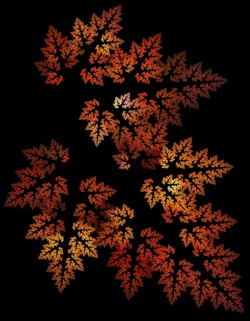A magazine where the digital world meets the real world.
On the web
- Home
- Browse by date
- Browse by topic
- Enter the maze
- Follow our blog
- Follow us on Twitter
- Resources for teachers
- Subscribe
In print
What is cs4fn?
- About us
- Contact us
- Partners
- Privacy and cookies
- Copyright and contributions
- Links to other fun sites
- Complete our questionnaire, give us feedback
Search:
Randomly rich art

There are lots of ways computer science techniques can be used to create innovative art. Fractals like the one pictured here are one example. They are created using simple rules that, when applied over and over, lead to beautiful and very natural looking images. They are self-similar in the sense that if you take any part of the image, however small, and blow it up you get something very similar to the original. Fractals are an easy way to create very realistic digital trees and ferns because the fractal process mirrors their natural development processes in the real world.
Software designer and visual artist Simon Schofield’s work is another example of computer science leading to novel art. He creates incredibly complex digital images made up of vast numbers of tiny drawn images. He has developed a set of special software techniques that put the full image together by following simple sets of rules that have a form of controlled randomness at their core. This leads to a kind of endlessly rich repetition. The results are amazing, capturing the detail and richness of natural textures but with an alien quality. Once you start looking at one, it's easy to get lost in it. Have a look yourself by following the link to Simon's website below. Sometimes the simplest rules can produce incredible things.


